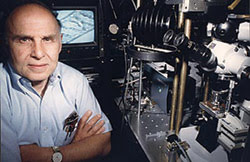39 Years After He Invented It
Although many scientists now use laser light to manipulate and confine biological cells and other transparent objects, only one person believed in the phenomenon 39 years ago. His name is Arthur Ashkin, and he is now 86 years old.
To demonstrate that light could move or trap particles, Ashkin had to prevent heat from the laser from burning the particles, so he used objects that are transparent and therefore absorb little or no heat. In 1970, he published a paper in Physical Review Letters describing the acceleration and trapping of microscopic transparent balls.
 Next he wanted to use a laser to manipulate atoms. However, he initially was unsuccessful, and his superiors at Bell Labs in Holmdel, N.J., cut his funding. He continued his work anyway and enlisted Steven Chu to do laser atom trapping with him, shortly after Chu joined the Holmdel lab. “I was this new, young person who he could corrupt,” joked Chu in a 1994 interview with Harry Kreisler for his program “Conversations with History.”
Next he wanted to use a laser to manipulate atoms. However, he initially was unsuccessful, and his superiors at Bell Labs in Holmdel, N.J., cut his funding. He continued his work anyway and enlisted Steven Chu to do laser atom trapping with him, shortly after Chu joined the Holmdel lab. “I was this new, young person who he could corrupt,” joked Chu in a 1994 interview with Harry Kreisler for his program “Conversations with History.”
In 1985, Chu and colleagues succeeded in trapping atoms. Although Chu won the Nobel Prize for this work, none of his co-workers would receive the coveted award, including Ashkin.
“Of course I felt left out [of the Nobel Prize],” Ashkin said. “The Swedish Academy wrote things in their press release that were false.” Those “things” were statements that Vladilen S. Letokhov did seminal work on optical trapping in the former USSR at the time that Ashkin was doing his work on optical trapping at Bell Labs. Ashkin believes that he alone deserves credit for this work and not Letokhov.
Once the prize is given, it defines history. William D. Phillips and Claude Cohen-Tannoudji won the prize with Chu. “Phillips starts talking about Ashkin being in Steve Chu’s group,” Ashkin said. “I had to teach Chu how to make traps.” Chu and Ashkin had equivalent job titles at Holmdel.
Ashkin has won many other awards, including election into the prestigious National Academy of Sciences, and the Keithley, Harvey and Rank prizes. His first paper is one of the most cited in the history of the American Physical Society, and he authored the definitive book “Optical Trapping and Manipulation of Neutral Particles by Lasers.”
Life less ordinary
The applications of laser tweezers have extended not only to physics but also to biology. In 1987, Ashkin and Joseph M. Dziedzic demonstrated the first application of laser tweezers in biology by manipulating E. coli and the tobacco mosaic virus.
Since then, many biophysicists have used optical tweezers to study biological molecules and organisms. Optical tweezers are one of only a few tools to measure the tension between molecules. Several companies now sell optical trapping setups.
The most promising practical non-research application of laser tweezers is sorting cells and other biological material in microfluidic devices. Laser tweezers enable more precise manipulation than fluid flow alone.
Today, Ashkin is retired but still does experiments in the basement of his home in New Jersey. As a result of the 1984 antitrust suit against Bell Systems, the Holmdel lab shut down and is now a “white elephant,” he said.